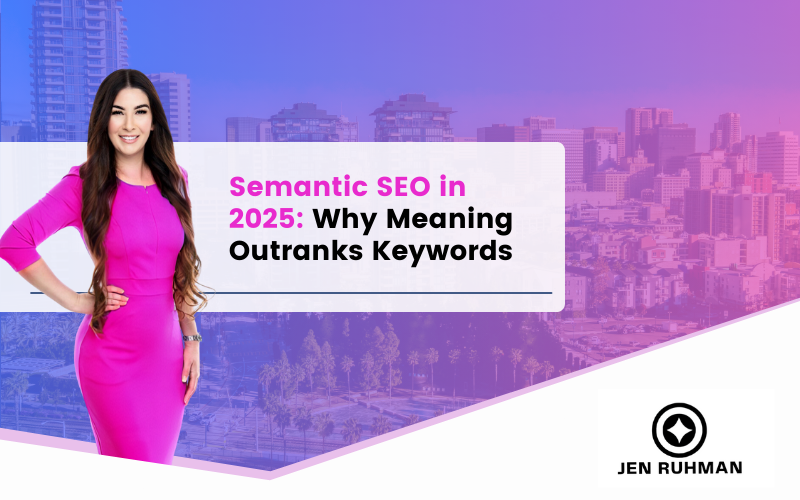Semantic SEO: Why It Matters More Than Keywords in 2025 (From a San Diego SEO Pro)
Call/text me: (619) 719-1315
As the owner of JenRuhman.com, a local SEO company San Diego, I’ve seen a big shift: in 2025, search engines reward meaning over exact-match keywords. That’s good news—if you know how to structure topics, entities, and intent.
The Quick, SGE-Ready Answer
Direct answer: Semantic SEO focuses on topics, entities, and relationships, not just keywords. In 2025, this matters more because AI-driven search (like SGE/AI Overviews) pulls trustworthy, well-structured, expert content that thoroughly covers a topic and answers real user intent. To win: build topic clusters, use schema, add helpful FAQs, and connect pages with purposeful internal links. If you need help, work with an SEO expert in San Diego who understands semantic architecture and E-E-A-T.
What Is Semantic SEO?
From Keywords to Concepts, Entities, and Relationships
Think of search like a conversation. Instead of asking for a single keyword, users ask about a concept: “How does Sculptra work, how long does it last, and is it safe?” Semantic SEO helps search engines connect all those ideas—product, benefits, risks, timeframes, and professional guidance.
Topic Clusters and Your Site’s “Knowledge Graph”
Topic clusters are groups of pages that cover a subject from multiple angles: definitions, how-to’s, comparisons, costs, and FAQs. When these pages interlink, you’re building a mini knowledge graph on your site. Search engines love it because it’s organized, thorough, and trustworthy.
Why Semantic SEO Beats Pure Keywords in 2025
AI Overviews (SGE) and How Engines “Understand”
AI systems summarize answers. They look for authoritative, structured, and cohesive coverage—not just keyword repetition. If your site explains a topic clearly, connects related entities, and cites supporting details, your chances of being summarized go way up.
E-E-A-T Signals Live Inside Semantics
Experience, Expertise, Authoritativeness, and Trustworthiness show up when your content is accurate, sources are clear, authors are real, and your organization is consistent across the web. Semantic structure makes these signals easier to detect.
A Simple Way to Start: Map Your Topic Universe
Entity Lists, People-Also-Ask, and Question Mining
List core entities (brand, services, products, locations) and map their relationships. Then mine questions from customers, your inbox, and People-Also-Ask. Those questions become headers, sections, and FAQs.
Build Clusters Around Core Services and Locations
In San Diego, service + location matters. For example, a “Personal Training San Diego” cluster might include cost, neighborhoods served, parking, intro session outline, and virtual options. Each page links back to the hub, and side-pages interlink where relevant.
Real-World Results From My San Diego Clients
Local Service Example: Med Spa Cluster Win
A med spa client came in with thin service pages and scattered blogs. We turned “injectables” into a cluster: treatment overviews, safety, longevity, pre/post-care, cost, and candidacy. We added LocalBusiness schema, author bios, and location-specific FAQs. Traffic rose, but the real win was more qualified consults.
Healthcare Example: Behavioral Health Cluster Win
For a behavioral health clinic, we structured a program hub (IOP) with supporting pages on insurance, conditions treated, outcomes, and care navigation. We used FAQPage and MedicalEntity schema and linked out to credible resources. The site earned rich results, broader query coverage, and higher conversion rates from organic.
Personal note: I’ve tested clusters on dozens of San Diego businesses—from salons to legal to medical. The repeatable pattern is clear: clusters + schema + strong internal linking = better rankings, better summaries, and better leads.
Structuring Pages for Semantic Relevance
Intent-Led Headings and Scannable Layouts
Lead with what the user needs now (price, safety, steps, timeline). Use short summaries at the top and expand below. Headings should mirror questions customers ask on the phone.
Schema Markup That Actually Moves the Needle
Use:
Article/BlogPosting for editorial pieces
FAQPage for persistent Q&A
LocalBusiness/ProfessionalService for NAP consistency
BreadcrumbList for structure
This creates machine-readable context that SGE can trust.
Internal Links: The “Wiring” of Meaning
Link hub ↔ spokes, and spokes ↔ spokes where relevant. Use descriptive anchors like “cost of treatment,” not “click here.” And, yes, link to your conversions pages with intent-matching anchors such as SEO company San Diego to reinforce your core entity.
Content That Answers People, Not Just Queries
Match Intent (Know, Do, Go, Compare)
Know: definitions, timelines, risks
Do: pricing, scheduling, how-to
Go: local directions, parking
Compare: side-by-side alternatives
Add Data, Definitions, and Clear Takeaways
Short, fact-based summaries at the top help SGE. Add glossaries and quick bullets. Back up claims with real numbers or plain-English explanations.
On-Page Techniques That Support Semantics
Lead With Summaries, Then Depth
Open with a 3–5 sentence answer box. Then deepen into sections with H2/H3s. This mirrors how AI Overviews scan and cite.
Use FAQs to Capture Long-Tail Meaning
FAQs are a natural place for “it depends” nuances, timelines, and edge cases. Keep answers concise and definitive.
Off-Page Signals That Reinforce Your Entity
Author Pages, Bios, and Consistent NAP
Show who wrote the content and why they’re qualified. Keep your Name-Address-Phone consistent across your site and citations.
Citations and Topical Mentions
Get referenced where your audience reads—local news, industry publications, and quality directories. It’s not just “links”; it’s proof you exist and do the work you claim.
Technical Must-Haves (Yes, They Still Matter)
Crawlability, Internal Architecture, and Speed
Make it easy for bots to discover and understand your cluster. Clean URLs, logical menus, and fast pages support semantics.
Index Hygiene and Canonicals
Index the pages that matter, fold thin duplicates, and use canonicals for variants. Clear signals prevent mixed messages.
How I Measure Semantic Wins (Beyond Rankings)
Query Diversity, Pages Per Session, and Conversions
When semantics click, you’ll see more diverse queries, deeper sessions, and better lead quality—not just higher positions.
AI Overview Placements and Rich Result Upticks
Track structured snippet appearances, FAQ rich results, and references in AI summaries. These are semantic KPIs.
Common Mistakes to Avoid
Publishing orphan pages with no internal links
Targeting the same intent on multiple pages (self-competition)
Over-optimizing for exact match while ignoring topical depth
Skipping author bios and LocalBusiness schema
Forgetting location intent for service businesses
Your 7-Step Action Plan for 2025
Define your core entities (brand, services, locations).
Build a cluster map for each service + location.
Write a hub page + 5–8 supporting pages with clear intent.
Add concise summaries at the top of each page.
Layer in Article, FAQPage, LocalBusiness, and Breadcrumb schema.
Interlink thoughtfully with descriptive anchors.
Measure query breadth, conversions, and rich result wins; iterate.
If you’re ready to build a semantic strategy that earns AI Overviews, rich results, and better leads, I’d love to help. I’m Jen—your local SEO expert in San Diego. Call/text me at (619) 719-1315 or visit my site to get started with a quick audit and a clear 30-day plan.
Keywords still matter—but meaning matters more. Semantic SEO is how you prove expertise, organize knowledge, and meet real user intent in 2025. When your content forms a connected, trustworthy picture of your business, search engines reward you with visibility where it counts: AI summaries, rich results, and qualified leads.
FAQs
Q1: Is semantic SEO just “LSI keywords”?
No. It’s about entities (people, places, things), their relationships, and covering a topic thoroughly with structure and intent—not stuffing synonyms.
Q2: How many pages should a topic cluster have?
Start with a hub and 5–8 supporting pages. Expand based on questions your customers keep asking.
Q3: Do I still need keyword research?
Yes, but it’s step one—not the strategy. Use keywords to map topics and intent, then build semantic depth.
Q4: Will schema alone get me AI Overview visibility?
Schema helps machines understand your page, but you still need helpful, comprehensive content and strong internal linking.
Q5: How fast can I see results?
Many local sites notice richer queries and better conversions in 30–90 days, especially when clusters replace thin, scattered pages.


